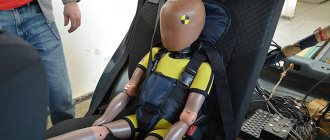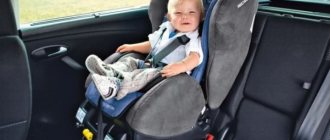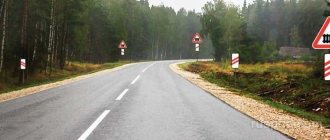Requirements for the driver
According to the rules for transporting people in the back of a truck, the driver cannot transport passengers (including loaders going to the site!) unless he has a document confirming the right to drive vehicles of the following categories:
- “C” – category (can transport up to 8 people, including passengers in the cabin)
- “C”, “C1”, “D1” – categories (can transport up to 16 people)
- “D” – category (more than 16 people can be transported)
In addition, the driver must have more than three years of experience driving cars falling into these categories.
"22. Transportation of people"
22.1 Transportation of people in the back of a truck must be carried out by drivers who have a driver’s license for the right to drive a vehicle of category “C” or subcategory “C1” for 3 or more years. In the case of transporting people in the back of a truck in the amount of more than 8, but not more than 16 people, including passengers in the cabin, it is also required to have an authorization mark on the driver’s license confirming the right to drive a vehicle of category “D” or subcategory “D1”, in in case of transportation of more than 16 people, including passengers in the cabin - category “D”. Note.
Military drivers are allowed to transport people in trucks in accordance with the established procedure.
22.2 The carriage of persons in the back of a flatbed truck is permitted if it is equipped in accordance with the General Provisions, but the carriage of children is not permitted. 22.2(1)
. Transportation of people on a motorcycle must be carried out by a driver who has a driver’s license for the right to drive vehicles of category “A” or subcategory “A1” for 2 or more years; transportation of people on a moped must be carried out by a driver who has a driver’s license for the right to drive vehicles of any category or subcategories for 2 or more years.
22.3 The number of people transported in the back of a truck, as well as in the interior of a bus carrying out transportation on an intercity, mountain, tourist or excursion route, and in the case of organized transportation of a group of children, should not exceed the number of seats equipped for sitting.
22.4 Before the trip, the truck driver must instruct passengers on the procedure for boarding, disembarking and placing in the back. You can start moving only after making sure that the conditions for the safe transportation of passengers are provided.
22.5 Travel in the back of a truck with a flatbed that is not equipped for the carriage of people is permitted only to persons accompanying the cargo or following its receipt, provided that they are provided with a seat located below the level of the sides.
22.6 Organized transportation of a group of children must be carried out in accordance with special rules in a bus or a truck with a van body designed for transporting people. When transporting a group of children in an organized manner, an adult accompanying person(s) must be with them. Transporting standing children is prohibited.
22.7 The driver is obliged to board and disembark passengers only after the vehicle has come to a complete stop, and to start driving only with the doors closed and not to open them until the vehicle has come to a complete stop.
22.8 It is prohibited to transport people: - outside the cabin of a car (except for cases of transporting people in the back of a flatbed truck or in a van), tractor, other self-propelled vehicles, on a cargo trailer, in a caravan trailer, in the back of a cargo motorcycle and outside the specified the design of the motorcycle seats; - in excess of the amount provided for by the technical characteristics of the vehicle.
22.9 Transportation of children under the age of 7 years in a passenger car and truck cab, which are designed with seat belts or seat belts and an ISOFIX child restraint system, must be carried out using child restraint systems (devices) that are appropriate for the weight and height of the child. — The name of the ISOFIX child restraint system is given in accordance with the Technical Regulations of the Customs Union TR RS 018/2011 “On the safety of wheeled vehicles.”
Transportation of children aged 7 to 11 years (inclusive) in a passenger car and truck cab, which are designed with seat belts or seat belts and an ISOFIX child restraint system, must be carried out using child restraint systems (devices) that are appropriate for the weight and height of the child , or using seat belts, and in the front seat of a car - only with the use of child restraint systems (devices) corresponding to the weight and height of the child. The installation of child restraint systems (devices) in a passenger car and the cabin of a truck and the placement of children in them must be carried out in accordance with the operating instructions for the specified systems (devices). It is prohibited to transport children under the age of 12 on the back seat of a motorcycle.
Vehicle requirements
According to traffic rules, to ensure the safety of passengers, the car body must be equipped in accordance with the following requirements:
- The seats must be securely fastened, and their height cannot exceed half a meter above the floor (and not lower than 0.3 m)
- The height of the side above the seats should not be less than 0.3 m
- Benches located at the back and sides should be equipped with reliable backs;
- The gap between benches should be 0.6 m
- Requires a roof over the body
- Working lighting must be installed inside
- It is mandatory to have a signal button to contact the driver of the car.
The presence of sharp elements inside the body is unacceptable; The edges of the seats and backrests must be smooth and non-hazardous. The staircase for passengers is installed on the rear side, to the right in relation to the movement of the car.
Side shutters “must” be in good condition and reliably protect the body from unexpected opening. For this, additional fixation is used.
Important: in the back you must have a fully equipped first aid kit and a working fire extinguisher.
Rules for transporting children in a car: traffic rules 2021
Let's go through the basic rules of the road, one way or another related to the transportation of children. However, one must understand that everything required for transporting people in general also applies to children, and the above standards must be met beyond this.
- Transporting children in the flatbed of a truck is prohibited (clause 22.2 of the Russian Traffic Regulations).
- Group (centralized) transportation of children must comply not only with traffic rules, but also with the norms of a special resolution of the Russian Government and other regulations, if any (clause 22.6 of traffic rules).
- Children under 7 years of age, including newborns (infants), must be transported only in special seats (cradles, with the help of restraint devices - hereinafter clause 22.9 of the Russian Traffic Regulations).
- A child from 7 to 12 years old can be transported in the front seat, but only using a seat, or in the back seat, using both a seat and regular seat belts.
- Restraint devices must correspond to the weight and height of the child, and be placed in the cabin in accordance with the instructions for their use.
- Children under 12 years of age cannot be transported on the back seat of a motorcycle.
The last point is the simplest - it is a direct ban that does not involve any nuances. Some other conditions need to be dealt with in more detail.
From the above rules it is clear that the age under 7 years is not differentiated for other periods - the norms for this age are common to everyone. However, it is easy to understand that in practice an infant and a 7-year-old child require different attitudes towards transportation. Traffic regulations dictate to us only compliance with height and weight, but this compliance also correlates with the age of the child (in most cases), and the type of restraint will depend on this, in turn.
Until the child feels more comfortable sitting, it is recommended to use a car seat, then you can move on to a car seat. Not a very specific definition, you will agree. But the law is interpreted in exactly this way, and there is logic in this: there are different types of devices, incl. transforming depending on the purpose - all types cannot be specified in the regulatory legal acts, and unnecessary clarifications may lead to the impossibility of operating some (especially new, recently developed) systems.
In addition to what has already been mentioned, the transportation of children under 7 years of age is characterized by one general rule - the presence of a restraint device is mandatory . The norm applies to all cases of travel in passenger cars and trucks, regardless of the location of the seat (cradle).
From the age of 7 until the age of 12, the rules for transporting children are less strict and depend on the location:
- When transporting children in the front seat, the use of a restraint system is mandatory.
- A child seat can be used in the rear seat, but seat belts can also be used.
A child not restrained in the back seat is a violation of the rules , with all the ensuing consequences.
This type of transportation of children is a rather specific issue that requires separate clarification. Here we will just briefly point out:
Organized transportation of a group of children is considered a non-route trip that involves 8 or more children not accompanied by parents/guardians .
We need to pay special attention to this issue. The phrase about the need to use belts / restraints, if provided for by the design, is found in all cases of children's transportation - both during private transportation in one's own car and during organized transportation of groups. Sometimes there is a misinterpretation of this point - supposedly it is enough to dismantle the seat belts / ISOFIX system so that transportation without seats or unfastened becomes legal.
This is far from true. Not intended by design means that initially, during the production of the vehicle, belts were not installed . If you dismantle the devices, but their presence is provided by the manufacturer, the car will not pass technical inspection, and therefore will not be allowed to drive.
In practice, you can now find not many passenger vehicles on the roads that do not initially require the installation of belts. At the same time, buses without seat belts for passengers, incl. used for group transportation of children, there are still a large number.
Rules for passengers
Often, when moving to a new place of residence, people turn to transport companies to rent a truck. At the same time, wanting to “keep an eye” on the property being transported, some people prefer to accompany the cargo, sitting in the back during transportation.
This is not prohibited even in cases where the car body is not equipped with all the necessary devices that give the right to transport people in it. However, here you will have to follow some rules:
- Sharp and dangerous objects cannot be accompanied without packaging that guarantees their isolation
- While the vehicle is moving, it is prohibited to move around the body, especially not to hang over the walls or sit on the edges of the sides.
- The seat should be located at least 0.15 m below the side level
Naturally, the cargo must be securely secured inside the body using special devices.
All these rules are needed to minimize the risk to human life and health while riding in the back of a truck. If you are moving with the help of a reputable logistics organization, then its employees will definitely take care of your safety. If you cope with the move on your own, do not forget about these conditions. There is a fine for violation!









